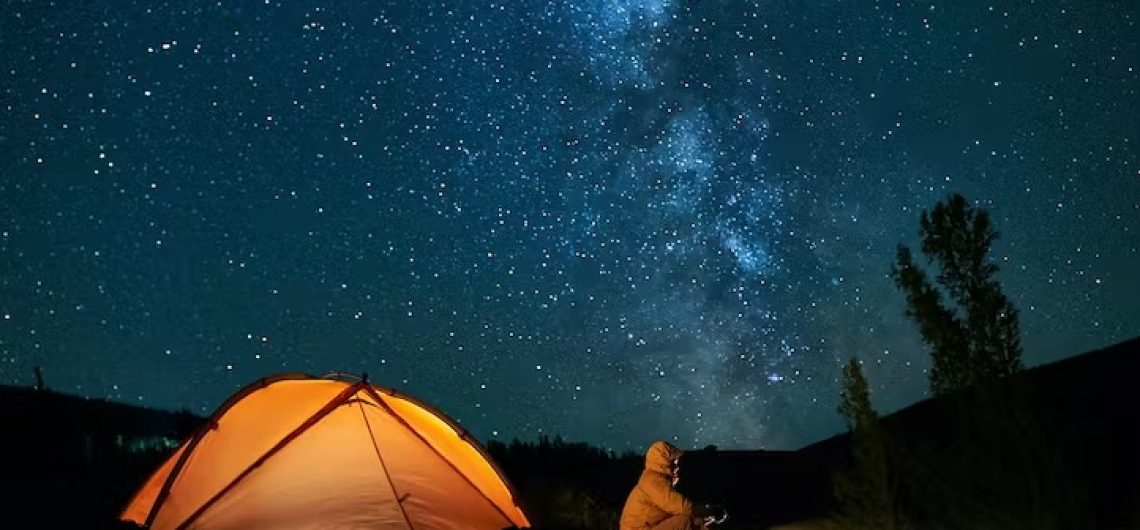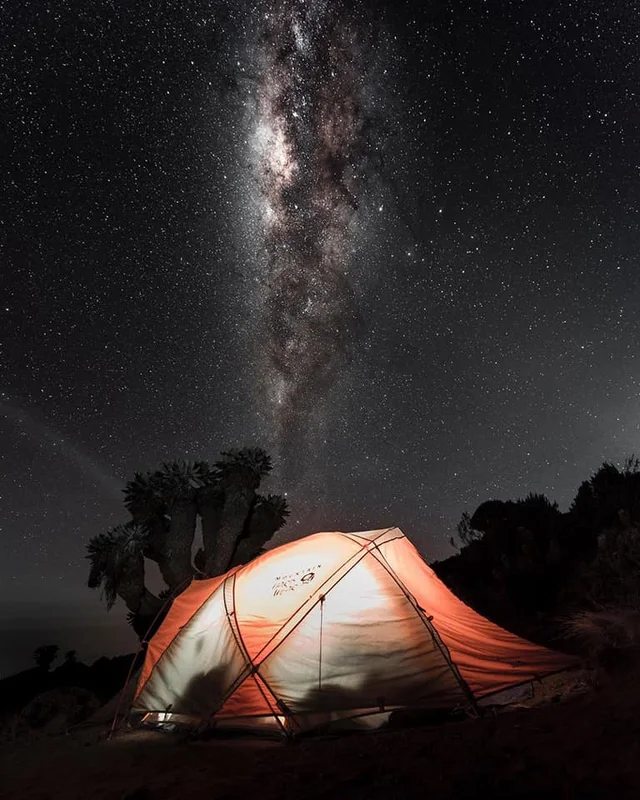You’re about to set out on a journey to view the stars, which are unquestionably one of nature’s most exquisite celestial displays, and the night sky of Kilimanjaro. However, there are also a lot of other cosmic wonders that have yet to be explored. To discover the wonder of innumerable stars and the moon itself, all you have to do is look upward into the canopy of the starry night sky.
The walk not only aims to locate the fabled constellations, but we also take advantage of the chance to identify some of the stars and constellations in the sky as we scale the highest free-standing mountain in the world and the roof of Africa.
After a few of hours of mountain hiking, the lengthy hours of darkness make for an excellent opportunity to see stars in the Kilimanjaro sky. Mount Kilimanjaro is a particularly excellent site for stargazing since there is very little light pollution there. The Milky Way and hundreds of dim stars that are invisible near towns may be viewed here. The best time to stargaze on Mount Kilimanjaro are days around the new moon dates.
Check out the full moon and new moon dates on Kilimanjaro here.
The best tips on how to stargaze on Mount Kilimanjaro
Below are the best tips to have a clear picture of how to stargaze on Mount Kilimanjaro, Africa’s highest mountain standing at a staggering height of 5,895m above sea level.
1. Find an open space higher up the mountain
You must go to an area with a) a clear, cloud-free sky, and b) little to no light pollution. When you gaze at the sky in such places, you may see stars. It should be higher up on the mountain in an open field or anywhere dimly lit.
2. Find a constellation
Once you locate such a constellation, it becomes a lot easier to find other constellations and stars from them. You can also get a book on stargazing or just simply ask someone who knows the constellation to show you instead of googling. Once you can locate the basic/common constellations, you can get a binocular or telescope and use them for deeper stargazing as you will be able to see the stars and planets and nebula and galaxies closer. You also need patience, time, and love for stargazing. It’s better to stargaze sitting in a foldable chair, or lying as the neck starts hurting if you look up at the sky for a long time. You can use laser pointers to point out stars specifically. Stargazing is fun and a very relaxing hobby. And the joy of recognizing a new constellation or viewing a star through a telescope is one of the purest forms of joy. Best of luck!
Finding additional constellations and stars from them is much simpler after you’ve located such a constellation. Instead of searching online, you could alternatively buy a book on observing the stars or just ask a friend who is familiar with the constellation to show it to you. Those cold dry seasons are the finest season for stargazing since there are practically no clouds, and you can start with Orion! It is really simple to find. Just search the night sky for three stars in a row! Google “how to discover additional constellations from Orion” will provide instructions. Alternatively, you might go online to see what constellations are visible from your region at this time of year. The good thing is that we now have internet on some parts of Kilimanjaro!
3. Use a binocular or telescope
You may use a binocular or telescope for more in-depth stargazing if you can identify the basic/common constellations since you will be able to view the stars, planets, nebula, and galaxies up close.
4. Be patient
For stargazing, you also need patience, time, and passion. It is preferable to lie down or recline in a deck chair when stargazing because prolonged stargazing causes neck pain. Star-specific laser pointing devices are available. Stargazing is a soothing and enjoyable pastime. One of the purest kinds of delight is discovering a new constellation or observing a star via a telescope. I wish you luck!
Read: Kilimanjaro and the top 10 stargazing destinations in the world
When is the best time to go star gazing on Kilimanjaro?
Consider planning your treks around the new moon dates when there is less light and the conditions are favourable for stargazing. The days leading up to, during, and immediately following each new Moon, when there is no Moon in the sky, are the best times to go stargazing on Kilimanjaro or anywhere else in the world. There is no bright Moon to block out the brightness from smaller stars at these times. The optimal time to observe the stars is after the Sun has sunk far enough below the horizon to prevent twilight from affecting observations. Additionally, you ought to stay away from moments when the Moon is brilliant in the night sky. The Milky Way may be vividly seen even in the absence of moonlight or twilight (depending on the time of year). Midnight. When the sun is at its lowest point below the horizon, the sky is at its darkest.
New Moon Dates 2023 – 2024 – Click here to see the full moon dates
| Month – Moon phase | New Moon 🌑 | Elevation & bearing | |
|---|---|---|---|
| August 2022 | 28th July at 2054 | 30° @ 249 | |
| September 2022 | 27th August at 1117 | -77° @ 153 | |
| October 2022 | 26th September at 0054 | 80° @ 043 | |
| November 2022 | 25th October at 1348 | 44° @ 060 | |
| December 2022 | 24th November at 0157 | 14° @ 064 | |
| January 2023 | 23rd December 2022 at 1318 | -54° @ 046 | |
| February 2023 | 21st January at 1155 | 35° @ 062 | |
| March 2023 | 21st February at 0009 | -47° @ 081 | |
| April 2023 | 21st March at 2027 | 20° @ 091 | |
| May 2023 | 19th April at 1916 | 31° @ 109 | |
| June 2023 | 19th May at 1856 | 11° @ 114 | |
| July 2023 | 17th June at 1939 | -48° @ 138 | |
| August 2023 (Supermoon) | 17th July at 2133 | 39° @ 117 | |
| August 2023 | 16th August at 1239 | -23° @ 108 | |
| September 2023 | 14th September at 1640 | -81° @ 105 | |
| October 2023 | 14th October at 2055 | -80° @ 323 | |
| November 2023 | 13th November at 1227 | -69° @ 000 | |
| December 2023 | 12th December at 1432 | -35° @ 058 |
What is the best weather to star gaze?
Typically, you’d prefer a cold(ish) night with the least amount of humidity, light pollution, and air pollution possible.
Of course, it doesn’t imply you can’t observe the stars in hot, muggy environments but the best time to climb Kilimanjaro are January to mid-March and June to October
What is the best star gazing app
For Android: Google Sky Map (free)
For iPhone: There are several, but we recommend Sky Safari. Three versions, the cheapest one will work fine for you ($2.99)
Related: 7 ways to hike Kilimanjaro under the full moon.
Star gazing guide for beginners
- First, choose a dark area away from city or town lights, then print a monthly sky map and calendar from a website like Publication Quality Sky Maps & Star Charts. Purchase a red flashlight (or cover the glass of a white light flashlight with red transparent plastic).
- Choose a week around the new moon next (when the moon is dark – astronomers call this dark time and it is best for seeing the night sky). Before you arrive at your observation place in the afternoon or evening, check the weather so you won’t be disappointed if it’s overcast. Obtain the compass instructions and arrive soon after dusk (E, N, W, S).
- Choose an easily recognizable constellation from your sky map, such as Scorpius, the Scorpion, Leo, the Lion, or Orion, the Hunter, depending on the time of year. As directed, position it for the appropriate compass direction and the time of night you intend to watch the sky. Now, while holding up the sky map and using the red light to illuminate it in the dark, try to match a pattern of stars in the sky (a constellation) with one that is depicted on the map. (After your eyes have adapted to low light, red light protects your ability to see at night.)
- Use a bright constellation you have discovered to lead you to additional (fainter) constellations. Observe how the stars have shifted from east to west after about an hour. For a few months, keep stargazing without binoculars or a telescope until you can identify four or five constellations and, if your site is dark enough, the Milky Way’s faint band. You may then advance to a telescope to examine specific objects, like as planets and comets, and begin using binoculars to gain stunning wide-angle views of star fields. Have fun on your ascent to the stars!
See also: Beginners guide to climbing Mount Kilimanjaro
The easiest constellations to see in Kilimanjaro’s night sky in Tanzania
In this region of Kilimanjaro in Tanzania, it is easy to view the following constellations:
Scorpio and Orion: Orion was a superb hunter and a very cocky individual. He once bragged that he could exterminate all the creatures on Earth if he so desired. The earth goddess Gaea was displeased by this, so she sent the scorpion to sting and kill Orion. Orion and the scorpion were both placed in the night sky as reminders, but legend has it that Orion was scared of the scorpion and retreated from it, which is why they are always 180 degrees apart in the night sky.
Cygnus the Swan: Legend has it that the deity Zeus assumed the shape of a swan in order to woo the goddess Nemesis. As a result of his accomplishment, he added the swan’s shape to the stars.
Canis Major: A mythical dog named Canis Major was bred to never give up a chase. He finally belonged to the hero Cephalus, who used him to fight the Teumussian fox (Canis Minor), a huge fox that was wreaking havoc on the land. The fox’s fate was to never be caught. Zeus sent the two creatures in the night sky so they may continue their pursuit for all time in order to reconcile their opposing destiny. Orion’s hunting dog, Canis Major is also famed for pursuing the hare, Lepus.
Taurus the Bull: He leads the pursuit in the night sky as Taurus the Bull. He is being pursued by Orion and his dog Canis Major. Although they are dispersed across the entire year, you will undoubtedly be able to view at least one of them when stargazing.
You’re most welcome to stargaze on Mount Kilimanjaro! Start getting in touch with us about your trek in Tanzania, and we’ll help you implement your plan.
![]()



Comments